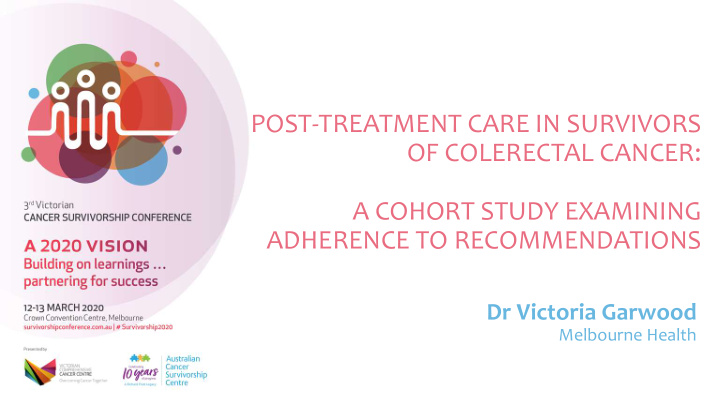



POST-TREATMENT CARE IN SURVIVORS OF COLERECTAL CANCER: A COHORT STUDY EXAMINING ADHERENCE TO RECOMMENDATIONS Dr Victoria Garwood Melbourne Health
Survivorship in Colorectal Cancer: A Cohort Study of the Patterns and Documented Content of Follow-Up Visits Dr. Victoria Garwood Dr. Karolina Lisy Prof. Michael Jefford
Introduction • 1.5 million people in the United States with a past diagnosis of colorectal cancer (CRC) [1] • Challenges can be physical, psychological, social, or practical • Practice guidelines for survivorship care released by the American Cancer Society (ACS) in 2015 [2] History and examination Post-treatment surveillance Wider survivorship care Care coordination • Aims of the retrospective cohort study 1. What are the patterns of follow-up visits in CRC survivors in the first three years following treatment, compared to the annual frequency recommended by guidelines? 2. To what extent is the documented content of these visits concordant with recommended guidelines? [1] Miller KD, Nogueira L, Mariotto AB, Rowland JH, Yabroff KR, Alfano CM et al. Cancer treatment and survivorship statistics, 2019. CA Cancer J Clin. 2019. doi:10.3322/caac.21565. [2] El-Shami K, Oeffinger KC, Erb NL, Willis A, Bretsch JK, Pratt-Chapman ML et al. American Cancer Society Colorectal Cancer Survivorship Care Guidelines. CA Cancer J Clin. 2015;65(6):428-55. doi:10.3322/caac.21286.
Characteristics of the Study Population (n = 48) Patient • Median age at curative resection 59 years (IQR 50, 69) • 56% female • 60% non-smoker Disease • Colon cancer (48%) Surgery only (57%) Surgery + adjuvant CTX (39%) Neoadjuvant CTX + surgery + adjuvant CTX (4%) • Rectal cancer (31%) Neoadjuvant CTX + surgery + adjuvant CTX (47%) Surgery only (20%) Neoadjuvant CTX/RTX + surgery (13%) Neoadjuvant CTX/RTX + surgery + adjuvant CTX/RTX (7%) Neoadjuvant RTX + surgery (7%) Surgery + adjuvant CTX (7%) • Rectosigmoid cancer (21%) Surgery only (50%) Neoadjuvant CTX/RTX + surgery + adjuvant CTX (20%) Surgery + adjuvant CTX (20%) Neoadjuvant CTX/RTX + surgery (10%) Figure 1 . Flow of participants (n = 206) through the cohort study.
71% Figure 2 . Patterns of follow-up in the study population over the Figure 3 . Frequency of follow-up visits (all specialties) in observational period (n = 48). the study population (n = 48) in the first year (360 days).
Figure 4 . Documented content of follow-up visits in the study population (n = 48) in the first year of follow-up (360 days).
• Most survivors have regular follow-up visits, but documentation does not consistently address wider survivorship care • Likely discrepancies in the role of various providers • Strategies to improve adherence: facilitated by EMR Conclusions • Limitations Documentation ≠ Consultation Skewed study population (complex, rectal) Small study population
Questions? Send your question via Slido https://www.sli.do/ Event code: # VCSC 20
Recommend
More recommend